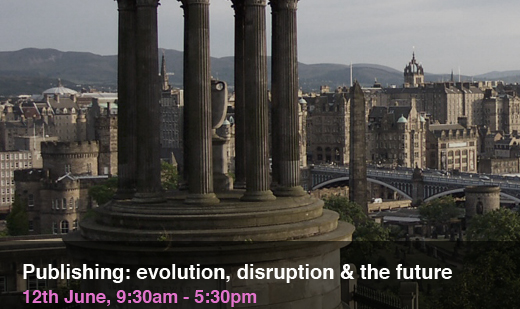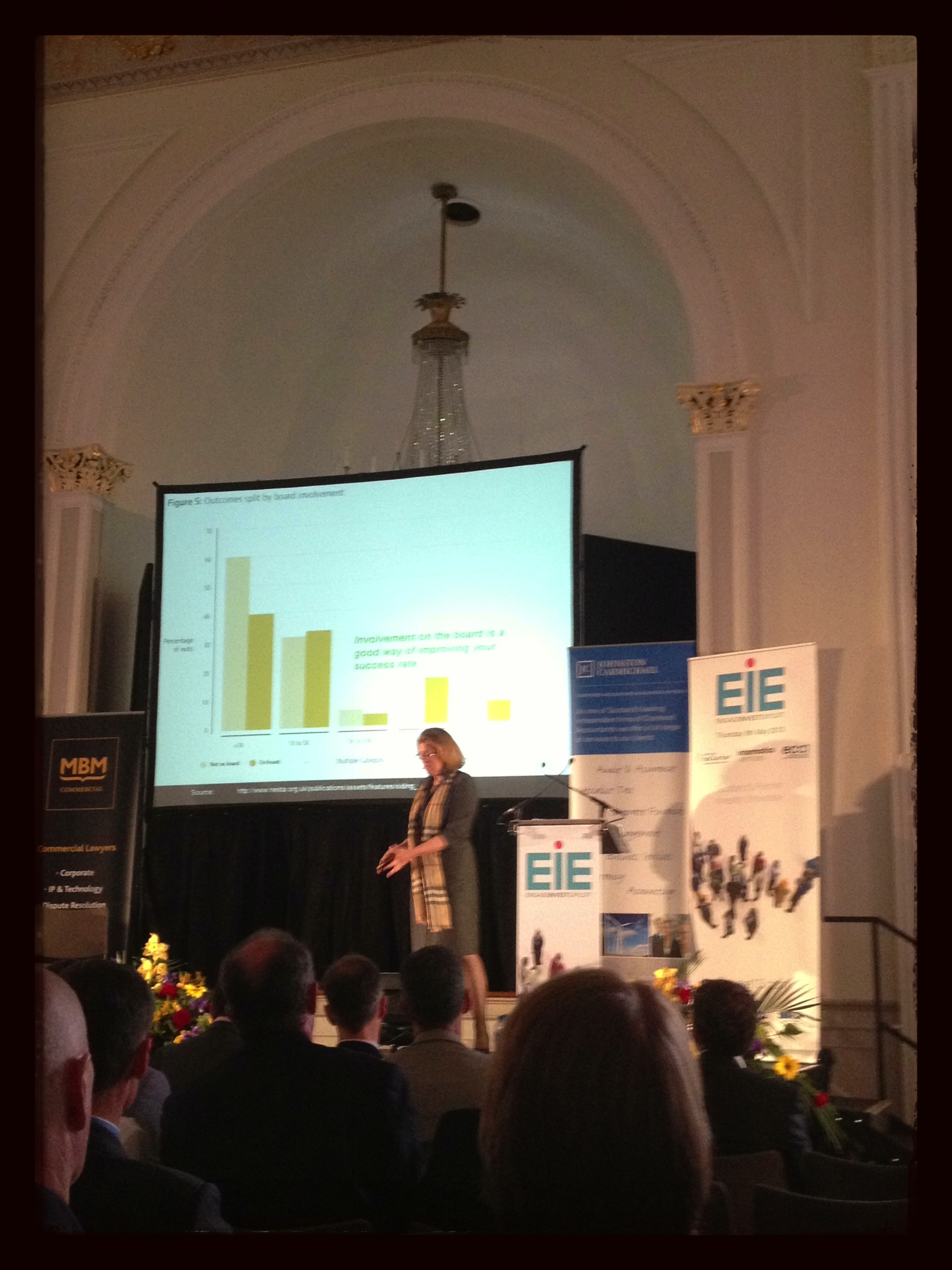
Mark Coker (@markcoker), Founder of Smashwords, the world’s largest indie book distributor, gave a great talk at the excellent Edinburgh Publishing Conference on the key trends driving the future of the book publishing industry.
The conference brought together a wide range of experiences from across the publishing industry under the title ‘Publishing: Evolution, Disruption & the Future’ and further posts will follow in due course.
Founded in 2008, Smashwords is now the world’s largest indie book distributor, with 60,000 authors and it shares data about what book sales looks like. Mark’s wife was a former reporter for a soap opera magazine. She told him that the actors and actresses in the soaps were more crazy in real life than their onscreen characters so they figured that there was great material there for a book based on interviews that would sell.
Together, they wrote a novel called ‘Boob Tube‘. They tried to get it published but received rejection after rejection for two years in a row. They had two options to dealing with such rejection – they could either accept failure or look for a solution. Their conclusion was that the problem wasn’t the book; the problem was the publishing industry which, they decided, was broken. Furthermore, the print industry in itself was harmful (to writers, readers, publishers etc).
Mark’s view is that the publishing industry has developed a culture of ‘no’. It’s the practice of rejecting the majority of opportunities based on an assessment of perceived commercial success. Yet Mark believes that every book has a right to be published even if that’s only going to be read by 10 people. The industry’s problem is that they may be rejecting future best-sellers because the industry is no position to judge what will be successful in reality.
So Smashwords was founded to answer the question – what if we could make it possible for any writer, anywhere in the world, to publish for free – meaning to upload, distribute and to get paid. The answer is that in their first year (2008), they published 140 books. In 2012, they published 230,000 books. We live in uncertain times. But that change brings both threat and opportunity to authors and publishers. Your reaction determines your outcome.
THE TEN TRENDS IN BOOK PUBLISHING
1. The rise of ebooks.
Reading is moving to screens. In the US, ebooks only accounted for around 1.1% of the market in 2008. In 2012, that figure had risen to around 30% of the market. The US is ahead of the world but the UK is coming up that curve quickly. Mark is certain that ebooks will overtake print in volume in due course. Whilst it is very important to know where we’re going as an industry, it is less important to know when we’re going to get there. In fact, the existing data underestimates the real value of the market as if you measure by words consumed onscreen. Ebooks are cheaper than print books, therefore the US must be close to the tipping point (probably this year if it has not already happened).
Why are ebooks so much better?
- Better reading experience (changeable font size)
- Lower cost (than print)
- Convenient (sampling & purchasing)
- Greater selection (huge)
2. Book selling (print and ebooks) is moving to the web
In the US, more books are published online than distributed in hard copy in book shops. The reasons for this are again price, convenience and selection. We all love bricks & mortar bookshops yet almost every single one of us is buying online. This has dramatic implications for traditional publishers. It also now means that a self-published author can be listed – because there is unlimited shelf space online.
3. Democratisation of Publishing
No more than five years ago, publishers controlled the printing presses, access to retail distribution & the knowledge necessary for professional publishing. When Mark tried to publish a book, he was a failed writer because without a publisher, he had nothing.
Yet today, the printing press, distribution networks and knowledge of professional best practices is free and available to all. Publishers are losing their monopoly and are no longer essential to the process. This means that writers are starting to ask two questions that are particularly dangerous for publishers:
- What can a publisher do that I can’t do myself?
- (Far more dangerously) Will a publisher harm my ability to reach readers? To which, the answer often is yes.
4. The self-published are gaining a competitive advantage
The advantages to self-publishing are numerous:
- Faster to get the book to market
- Greater creative control (if a publisher already has 3 books on paranormal bunny rabbits, they’re not going to publish yours, however good it might be…)
- Lower expenses
- Your books never goes out of print
- Better royalties
It’s worth considering the royalties further. Independent publishers are getting royalties of 60-80%, compared to 12-17% in traditional publishing. This means that at a price of £2.99, indie authors would earn roughly £2 per book. For a traditional author to earn an equivalent amount, the book would have to be priced much higher, at around £10 – £15. It doesn’t take a genius to see that a consumer will buy the cheaper product! And with a lower price, it means that the author has the potential to reach more readers and therefore to make more sales at higher profits per sale.
5. Book buyers are price sensitive
There are arguably two benefits for an author from every sale of a book. The first is obvious – money, in the form of a royalty. But the second – and more valuable – is that you gain a reader. This is more important because every reader is a potential fan. And each one of those is a potential super fan. These are people who will buy everything that you write and also act as your marketing department for free. [Note: apologies for yet again referring to this post but this ties in with one of the most important blog posts that I’ve ever read – 1000 True Fans – if you haven’t read it, I promise you, it’s important]
Smashwords carried out research into their sales in order to work out the price at which an author can reach the most readers. A free price means that you’ll reach 100x more readers than you’ll reach at any other price – but you can’t make money (directly). The evidence shows that readers don’t respond well to $1.99 – an author can sell more books at $2.99 or $3.99 and that $3.99 earns more than any other price point. I’ll probably dive into this in more depth in a future blog post but for now, you can check out the post at ‘New Smashwords Survey Helps Authors Sell More eBooks‘.
6. Print is dead for most self-published authors
Brick and mortar bookstores are disappearing. They are essential if you’re looking to sell print books but you don’t need access to them if you are self-published (with a few minor exceptions – such as for public speakers selling hard copies at the back of the room).
7. Ebooks are going global
Mark believes that the market for English language books outside the US will soon become larger than the market within the US. Demand is exploding. Ebook retailers are going global (Apple iBookstore is in 51 countries, Amazon in 12, Kobo in 14; 44% of Smashwords/iBookstore sales are global)
8. Big publishers are getting into self-publishing
In July 2012, the parent company of Penguin (Pearson) acquired Author Solutions. As Mark explained in strong terms, Author Solutions is in the business of selling services to authors yet most of their revenues are derived from selling to authors who are not already selling. He argues that this shows precisely how incredibly out of touch how some of the big publishers are – by attempting to simply sell services to authors to make money. His view is that this goes against the fundamental principle of publishing which was always about investing in writers. The money in the industry should always flow from publisher to author and never the other way around.
9. Previous stigma of self-publishing is disappearing
Self-publishing used to be seen as the option of last-resort. There was shame associated with it, with fellow writers who had been professionally published mocking those who took the self-publishing route. This was down to the myth that pervaded the industry: that if you were good enough, a publisher would happily publish you and that if you then listened to what the publishers wanted (regarding genre choices etc), you would then be successful. Now we’re seeing this stigma totally disappearing, with indie authors often publicising the fact as a badge of honour.
Mark believes that we will have a day in the future when more writers aspire to be self-published rather than published. At this stage, we will have truly shifted from a culture of saying no and telling writers that they suck to being in a position where every writer can start working today with the 100% assurance that his or her final work can be published.
10. Indie authors are beginning to outsell traditionally published authors
The New York Times bestseller list now has self-published authors on that it every single week. One year ago, that was very rare. Mark believes that within the next three years you will see a tipping point where more authors are self-published than take the traditional route. Indeed, if you look at iBookstore in the US today, six of the top ten today are self-published. Today’s top-selling ebook in the world is a Smashwords book
So What Next?
Taking account of these ten trends, it’s clear that a future is evolving that benefits self-published authors. You have the opportunity to publisher faster, smarter and more profitably, at lower prices.
If you’re a writer, recognise that you’re now in charge. You now decide when you graduate to become a published author. But be aware that this with this opportunity comes responsibility. Readers want quality books. Therefore, each author must assume all the best practices that every top publisher would previously carry out (i.e. ensure each book is well-written, well-edited, has great cover art, distribution etc).
And what if you’re a publisher? Well, the good news is that not all authors want to become self-publishers because it’s a lot of work. But the difficulty is that it’s going to become harder for you to add value. Yet your opportunity remains in seeking to do for authors what they cannot/do not want to do for themselves. If you’re a publisher, think carefully about the culture of saying no – because every time that you say no to an author, you’re sending them down a different path that probably means they won’t return to you if they’re successful.
Mark believes that there has never been a better time to be in publishing. The world needs more smart people in publishing adding value to books. The question of indie/traditional publishing tends to be framed as an either/or battle but it doesn’t need to be.
Above all, ensure that, whatever you do, you add value to books.
Note: three (free) handy guides to self-publishing (also available on Amazon):-
Secrets to Ebook Publishing Success
Smashwords Book Marketing Guide
photo credit: Creativity+ Timothy K Hamilton via photopin cc









